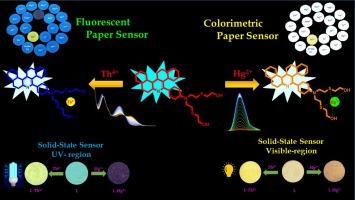New phenanthridine-based multi-functional chemosensor for selective detection of Th4+ and Hg2+ ions in both aqueous and solid state
IF 4.3
2区 化学
Q1 SPECTROSCOPY
Spectrochimica Acta Part A: Molecular and Biomolecular Spectroscopy
Pub Date : 2024-10-21
DOI:10.1016/j.saa.2024.125312
引用次数: 0
Abstract
A new phenanthridine-based multifunctional chemosensor (L), was synthesised via a green synthetic route and characterised using FT-IR, NMR and HRMS analysis. The sensing application of L towards metal ions in both solution and solid-state was studied using UV–vis and fluorescence spectroscopy, which exhibits dual-sensing behaviour for Th4+ and Hg2+ ions with good recyclability. In aqueous acetonitrile, L showed rapid response for the detection of environmental toxic metal ions and has a very low analytical detection limit of 125.5 pM and 1.94 nM for Th4+ and Hg2+ions respectively, which is remarkably lower than the World Health Organization standard. The cation binding property of the L with Th4+ and Hg2+ions was investigated by Job plot, 1H NMR titration, HR-MS and DFT calculation. The in-situ formed ensemble L-Hg2+ was further applied in the naked-eye detection of Cys (Cystine) and His (Histidine) over other common amino acids. The utility of L for real-time detection of Hg2+ and Th4+ ions was explored in various sources of environmental water samples, test paper strips, fingerprint imaging, fluorescent ink and smartphone-assisted sensing techniques, demonstrating the promising on-site visualization of the probe in controlling the toxicity levels in wastewater sources without resorting to expensive instruments.

基于菲啶的新型多功能化学传感器,用于在水溶液和固体状态下选择性检测 Th4+ 和 Hg2+ 离子
通过绿色合成路线合成了一种基于菲啶的新型多功能化学传感器(L),并利用傅立叶变换红外光谱、核磁共振和 HRMS 分析对其进行了表征。利用紫外-可见光谱和荧光光谱研究了 L 在溶液和固态中对金属离子的传感应用,发现它对 Th4+ 和 Hg2+ 离子具有双重传感行为,并具有良好的可回收性。在乙腈水溶液中,L 对环境有毒金属离子的检测反应迅速,对 Th4+ 和 Hg2+ 离子的分析检测限分别为 125.5 pM 和 1.94 nM,明显低于世界卫生组织的标准。通过 Job plot、1H NMR 滴定、HR-MS 和 DFT 计算研究了 L 与 Th4+ 和 Hg2+ 离子的阳离子结合特性。原位形成的 L-Hg2+ 合集被进一步应用于肉眼检测 Cys(胱氨酸)和 His(组氨酸)以及其他常见氨基酸。在不同来源的环境水样、试纸条、指纹成像、荧光墨水和智能手机辅助传感技术中探索了 L 对 Hg2+ 和 Th4+ 离子实时检测的实用性,证明了该探针在不借助昂贵仪器的情况下现场可视化控制废水源毒性水平的前景。
本文章由计算机程序翻译,如有差异,请以英文原文为准。
求助全文
约1分钟内获得全文
求助全文
来源期刊
CiteScore
8.40
自引率
11.40%
发文量
1364
审稿时长
40 days
期刊介绍:
Spectrochimica Acta, Part A: Molecular and Biomolecular Spectroscopy (SAA) is an interdisciplinary journal which spans from basic to applied aspects of optical spectroscopy in chemistry, medicine, biology, and materials science.
The journal publishes original scientific papers that feature high-quality spectroscopic data and analysis. From the broad range of optical spectroscopies, the emphasis is on electronic, vibrational or rotational spectra of molecules, rather than on spectroscopy based on magnetic moments.
Criteria for publication in SAA are novelty, uniqueness, and outstanding quality. Routine applications of spectroscopic techniques and computational methods are not appropriate.
Topics of particular interest of Spectrochimica Acta Part A include, but are not limited to:
Spectroscopy and dynamics of bioanalytical, biomedical, environmental, and atmospheric sciences,
Novel experimental techniques or instrumentation for molecular spectroscopy,
Novel theoretical and computational methods,
Novel applications in photochemistry and photobiology,
Novel interpretational approaches as well as advances in data analysis based on electronic or vibrational spectroscopy.

 求助内容:
求助内容: 应助结果提醒方式:
应助结果提醒方式:


